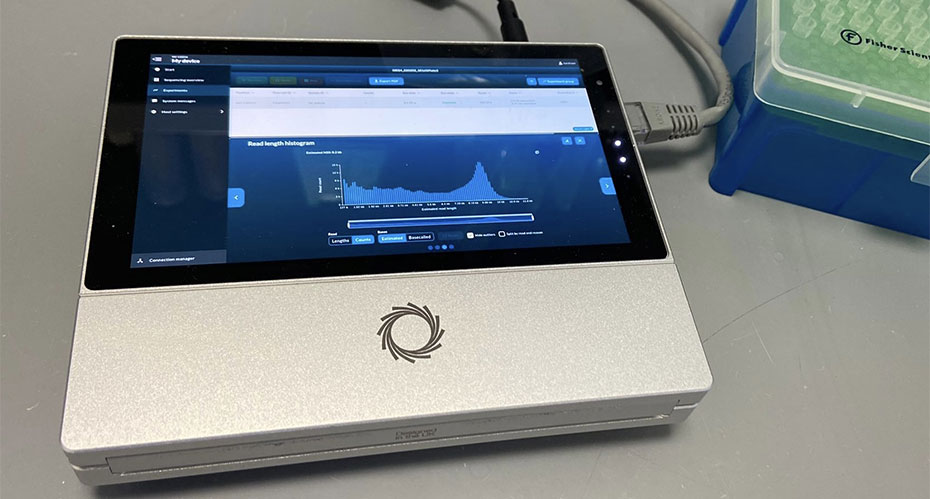Preparing samples for Nanopore DNA sequencing
Nanopore sequencing (along with other single-molecule technologies) have stringent requirements for input DNA samples. Remember that single molecules of DNA are being sequenced and in most cases DNA is not PCR amplified prior to sequencing. This means that any contaminants or damage to the DNA will adversely affect the quality of your sequencing data. As such input DNA must be of high quality to prevent the DNA library from blocking the pores during sequencing. Poor input will guarantee poor results.
Follow these guidelines for sample preparation:
- Minimum 5 ug of high quality, high molecular weight DNA preferred. We can work with less but shearing to a smaller size maybe required. Note: Spectrometers tend to overestimate, recommend fluorometry using PicoGreen or Qubit fluorometer.
- OD 260/280 spectrometer ratios (NanoDrop) should be between 1.8 and 2.1. Ratios below < 1.8 are indicative of protein phenol or glycogen contamination
- OD 260/230 spectrometer ratios (NanoDrop) should be between 2 and 2.2. Ratios < 2 or > 2.2 are indicative of contaminations of salts, RNA or phenol contamination
- DNA shows high molecular weight - run 100ng on an agarose gel (e.g. 0.8% agarose gel, ran slowly with a a molecular weight marker indicating at least 20kb or greater) or fragment analyzer
- Ensure DNA is submitted either frozen and on dry ice, if it was freeze stored previously (-20 °C). If it has recently been extracted, it should be submitted at 4 °C (on ice).
- Elute in Qiagen Elution buffer or Low TE buffer (10mM Tris HCl (pH 8), 0.1mM EDTA)
- Ensure DNA is stored at a maximum of -20 °C :
- Do not freeze-thaw
- Do not expose to high temperatures (>65°C). This may cause nicks or other damage to the DNA
- Ensure pH is between 6-9
- Ensure the DNA is free from contaminants:
- Make sure it is double stranded, does not contain insoluble material and is not coloured or cloudy
- Take care to remove proteins (e.g. with the generous use of proteinase K)
- It should not contain RNA (Use RNase to remove RNA)
- It should not be exposed to DNA damaging conditions such as intercalating fluorescent dyes or UV radiation
- It does not contain chelating agents (e.g., EDTA), divalent metal cations (like Mg 2+), denaturants (like guanidinium salts, phenol), or detergents (like SDS, Triton-X100)
- It should not contain carryover contamination from the starting organism/tissue (e.g., heme, humic acid, chitin, polysaccharides, polyphenols, etc.)
Please submit ALL of the following quality control information:
- Gel picture (0.6 – 0.8 % agarose for genomic, 1-1.5 % for amplicons; including a high molecular weight size marker indicating at least 20kb or more e.g. here )
- Information about OD260/280 and OD260/230 ratios
- Estimation of concentration, and which instrument was used (preferentially Qubit)
- Information about the extraction protocol
- Type of solvent that DNA is stored in (preferably, LowTE or EB buffer)
Other important handling recommendations include:
- Purchase and use wide bore tips to prevent DNA shearing where possible
- Do not vortex DNA
- Minimize pipetting
- Use low DNA binding micro centrifuge tubes or LoBind plates.
Recommended DNA clean up
- PowerClean-DNA-Clean-Up (download pdf) to remove residual gDNA isolation reagents that may inhibit the polymerase binding essential for successful sequencing. The kit removes heme, polysaccharides, phenols, and dyes.
- Phenol Chloroform extraction
DNA extraction protocols
- A collection of publications from PacBio describing high molecular weight extraction from vertebrates, invertebrates, plants, fungi and protists which are equally applicable for nanopore sample collection
- Protocols.io also shows a number of protocols for long read sequencing as well as discussion on "high molecular weight DNA extraction from all kingdoms"
- Preparing samples for long read whole genome seluencing for de novo assembly, provided by PacBio but equally applicable to ONT samples– collection and storage
Library Guidelines
If you are preparing your own Nanopore libraries then please contact us before beginning the library preparation at bioscience-sequencing@exeter.ac.uk




